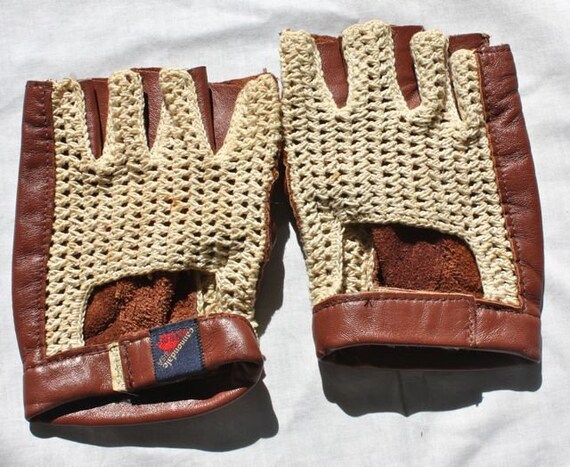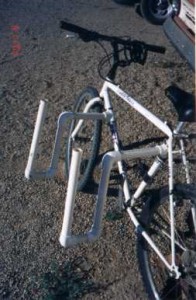Unless you’re a purist who keeps your fixed gear
bike NJS-compliant or someone who doesn’t ride much beyond your neighborhood,
you use some sort of hydration system.
Some of you use “Camel Back” type backpacks that
hold bladders. I did when I was doing a
lot of mountain biking, although I’ve never really liked carrying anything on
my back when I ride. But now I, like most of you, use a bottle-and-cage
system. For all of the diversity of cage
materials and designs, most bottles marketed for use on bicycles fit on most
cages. That means you can buy a cage
from someone who makes cages, not bottles (like King, who made the stainless steel cages I use) and not have to worry about whether your bottle will fit
into it.
Most bikes sold today have threaded bits on the downtube (and, sometimes, the
seat tube) for mounting cages. But, back
in the ‘70’s Bike Boom--around the time I became a dedicated cyclist—most
bicycles didn’t have them. In fact,
about the only bikes that came with such provisions were made by constructeurs and other custom
builders. Even top professional-level
bikes like the Raleigh Professional and Schwinn Paramount didn’t have bottle
mounts.
That meant you needed a pair of clamps—which, in
those days, were usually supplied with the cage. Some would argue that a true “vintage”
restoration should include a cage with such clamps—unless, of course, the frame
is from a constructeur or other
custom builder. If you look at racing
photos from before the early ‘80’s or so, even the top professional
riders—including Eddy Mercx on his sunset-orange De Rosa—you can see the
clamps.
It was during that time that a few enterprising
companies—some of them in the US—came up with some interesting ways of mounting
bottles on bikes.
 |
| One-clamp cage from Specialites TA, ca. 1975. |
Specialites TA of France, which made the cages
most racers and high-mileage riders used in those days, made a single-clamp
cage. I mounted one on my Romic and
never thought about it: Like TA’s other
cages, it held the bottle securely while allowing easy removal and was all but
indestructible.
A Tennessee-based company called Hi-E, which made
ultra-lightweight (for the time, anyway) hubs, pedals and other components,
came up with their own version of TA’s cage.
Hi-E made their cage from aluminum alloy and it was fixed to the frame
with a stainless steel hose clamp.
American Classic would later make a similar cage in Ohio, along with its
own lightweight components.
Others found ways of doing away with the cage
altogether. Rhode Gear came up with what
was probably the most popular of them.
Their bottle had an extrusion with “tracks” on each side that fit into
grooves on the plastic clamp mounted onto the bike. It was actually quite good—I had one on myPeugeot “fixie”—and became very popular with club cyclists. Other companies imitated it.
 |
| Rhode Gear bottle, ca. 1978 |
Its advantages were its simplicity and (if you’re
a weight weenie) the elimination of 100 grams or so of steel cage and
clamps. Also, it could be mounted on the
seat tube of a bike with short chainstays and little clearance between the tire
and seat tube. In fact, I put another
Rhode Gear bottle on my Trek racing bike, which had water bottle mounts on the
down tube but not the seat tube.
Plus, after a while, they were made in a bunch of
colors as well as basic white and black.
The white ones could be had with the logos of a few large bike
manufacturers (I had one with a Peugeot emblem) or, for a time, with club logos
or other custom designs.
The disadvantage, as you may have figured, is that
it was a proprietary design: You could
only use the bottle designed for the system.
At least the bottle was easy to use and sturdy: I never heard of one cracking or springing a
leak, though a few wore out at the tracks, albeit after a lot of hard usage.
Cannondale
made a bottles that attached to its “mated” holders with Velcro. I never tried such a bottle, but a few riders
I knew liked them. The best thing about
them, it seemed, was that the bottle could be put into the holder from any
angle. As one fellow club rider said,
“When I’m tired, my aim isn’t as good.”
While riding, he could put the Velcro-coated bottle back in its holder
without looking at it.
 |
| Cannondale bottle and "cage" with Velcro |
One other cageless bottle I used had indentations
on its sides designed so that the bottle would “snap” in between the seat stays
of most bikes. Most bikes at that time had parallel stays of more or less the
same diameter placed more or less the same distance apart. Of course, such a bottle wouldn’t work on
many of today’s bikes, including those with monostays. Also, as you might expect, the bottle was
small: less than half the size of a
standard water bottle. It did come in
handy, though, especially on a training ride on a hot day.
I don’t know what happened to that bottle. I think I stopped somewhere, drank from it
and absentmindedly left it. When I
realized I no longer had it, I couldn’t find another: Apparently, they were made only for a year or
two.
As water bottle cage fixtures became standard
features on mass-produced bikes, the demand for cageless bottles and
single-clamp cages fell off. By the late
1980s, it seemed that no one was making them anymore.
 |
| RDR Bologna bottle |
However, a few years ago, RDR Bologna made a
water bottle with a slot in the rear that’s designed to slide directly onto the
water-bottle braze on. I haven’t used
one, and don’t know anyone who has. But,
from what I can see, it has all of the advantages and disadvantages of the
Rhode Gear bottles I used back in the day.












